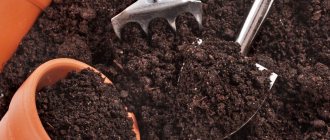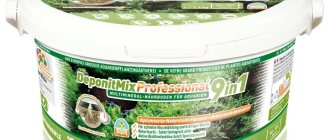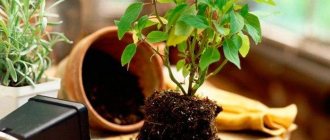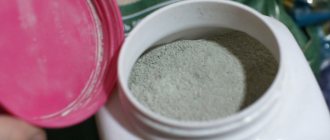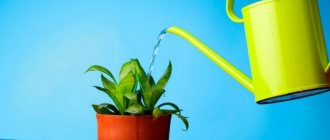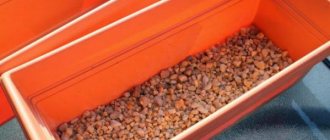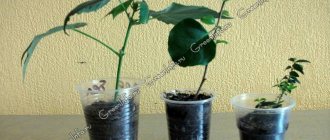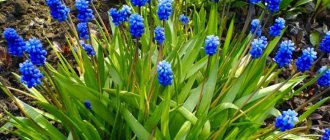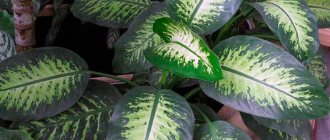It is a known fact that proper care of indoor plants extends their lifespan. One of the factors of proper care is replanting into a larger pot with fresh soil. The intervals between transplants are different for all plants, but still in this article we will try to systematize this data and consider the basic principles and rules of correct transplantation.
Most perennial plants need to be replanted once a year or every two years; some slow-growing plants need to be replanted once every three years.
There are three main types of replanting, depending on how much land was replaced:
- Complete transplant
. During such a transplant, all the soil is replaced, making sure to clear the roots of the plants from the old soil. - Partial transplant
. For such a transplant, there is no need to disturb the roots; it is enough to replace the soil around the rhizome. - Replacing the top layer
. This type of replanting is suitable for situations where it is enough to “sprinkle” the bare root of the plant or in cases where it is necessary to remove the top layer and fill the vacant space with fresh soil.
Soil characteristics
In order not to make a mistake with the choice of soil, you need to know its main characteristics and correlate them with the requirements of a particular type of substrate.
The main characteristics of the soil include:
- porosity and looseness of the soil, which determine air penetration (soil aeration);
- ability to pass moisture (moisture permeability);
- ability to retain moisture (moisture capacity);
- nutrient conductivity;
- acidity level - pH. If Gloxinia, Hydrangea, Dieffenbachia require a slightly acidic environment (pH 6.0–6.5), then Rose, Cineraria, Chrysanthemum require a neutral environment (pH 6.5–7.0), and a slightly alkaline environment is suitable for Adenium and Narcissus. As a rule, the pH is indicated on the soil package.
Peculiarities
Bulbous and tuberous houseplants can be wonderful additions to any interior. Such details do not make the environment oversaturated or irritating; on the contrary, with flowers the interior composition becomes more aesthetic and pleasant. But it’s not enough to just choose your favorite representative of the green world. You still need to properly care for it and take into account all its features. If you don’t give a damn about the flowers of the type in question, they are unlikely to delight household members with their beauty for a long time.
Bulbs and tubers are underground storehouses, thanks to which the plant calmly survives various bad weather, low temperatures or dry periods. These are peculiar organs, saturated with all the necessary nutrients. Thanks to them, the plant can quickly form new shoots after a mandatory dormant period. From the tubers it is possible to grow very beautiful ornamental flowering plants.
After flowering, such green pets die off, leaving behind living baby tubers that can germinate in conditions that are comfortable for them.
Bulbous representatives of their species can be classified as a separate category. In their arsenal, these individuals have a bulb, which acts as a separate bud. In addition, this part is needed to store moisture. The main distinguishing feature of such flowers from other existing plants is the presence of a certain number of leaves, initially located in the inner part of the bulb. On one side of the latter there is a small bottom, where there is an initial root system.
Both bulbous and tuberous flowers can look impressive and elegant if you provide them with the most comfortable conditions for growth. When developing a scheme for caring for flowers of these types, it is necessary to take into account the characteristics of the species to which they belong, and there are a lot of them.
Soil composition
To make the right choice, you should pay attention to the composition of the soil mixture. It determines how often watering, replanting, fertilizing and their quantity are required.
High peat
High-moor peat (a product of the decomposition of sphagnum growing in raised bogs) is part of most soils. It is widely used in its pure form for cultivation both in private, indoor culture and in agriculture. High-moor peat is characterized by high moisture capacity, breathability and lightness. It is these properties that made it a leader among other primers. An additional “bonus” for residents of regions with hard water in the water supply is the acidic environment of peat. It moderately neutralizes salts when watering, although this effect is short-lived.
Indoor plants are rarely grown on pure peat, because it is extremely poor in nutrients. In addition, unwatered peat has difficulty absorbing moisture. Those who use soils based on high-moor peat know what a headache watering such a substrate becomes. The pot with overdried soil should be placed in a basin of water and wait until the peat has collected the required amount of moisture.
Lowland peat
Lowland peat (obtained from low-lying bogs, wetlands) is rich in nutrients. That is why it is used mixed with high-moor peat as part of the most popular soils for indoor plants. In its pure form, lowland peat is not used at all: due to its fine structure, it is quite “heavy”, quickly cakes, retains water and has low air permeability. This factor can play a cruel joke, for example, with aroids, the roots of which are easily damaged due to stagnation of water.
Sod land
Similar to “vermicompost”, the glory of turf soil is popular among people. Sod is the root-inhabited part of the soil. As with humus, turf soil can be different, which means it is impossible to talk about a single quality standard for such soil. Its quality depends on the specific location: if on the territory of abandoned collective farms/state farms the turf soil is good, then in the field it is not so good. The main disadvantage of turf soil is the need to remove residues of other plants, followed by steaming to remove possible microorganisms.
For independent experiments, it is better to use soil from garden farms where fruit trees are cultivated. “Coniferous soil” is very popular - it is light, aerated, has a slightly acidic reaction and is in many ways similar to peat, although it does not dry out so much that you have to soak the pot with the plant for hours. Almost any sod-leaf soil is relatively poor in nutrients (or slowly releases them).
Light, medium and heavy earth mixtures
Why do the leaves of indoor flowers turn yellow - what to do?
The composition of the substrate is divided into several types:
- lungs;
- average;
- heavy.
The light mixture includes 40% peat, 15% garden soil, 5% leaf or turf soil, 40% sand. In addition, it is necessary to add additional components: agroperlite, vermiculite, charcoal, fine expanded clay. The light mixture is ideal for the following indoor plants:
- desert cacti;
- succulents with thickened leaves.
To root cuttings with a weak root system in a pot, light mixtures are also used, but during growth it is necessary to periodically fertilize additionally.
For the average mixture the following components are required:
- peat - 30%;
- garden soil - 25%;
- leaf or turf soil - 15%;
- humus - 5%;
- sand - 25%;
- vermiculite and charcoal as additional components.
Medium soil mixtures are considered universal. Suitable for palm trees, some types of succulents, and decorative foliage indoor plants.
Note! If in doubt about the selection of soil for your flower, it is better to loosen it a little by adding the appropriate components.
To obtain heavy soil mixtures, you need to take 35% of peat, 25% of soda soil, 20% of leaf or turf soil, 10% of sand, 10% of humus. Additional components include wood bark, pine needles, sphagnum, and charcoal. Heavy soil mixtures are prepared for the following types of house plants:
- tropical palms;
- vines;
- ferns;
- azaleas;
- begonias;
- fuchsia;
- tropical cacti.
Large plants with a well-developed root system are also planted in heavy soil.
Most of the ingredients in the mixtures can also be prepared independently.
Humus soil
Compost or humus soil is obtained from animal manure. Horses and cows usually provide good material. It is placed in a compost pit or simply on a heap, well covered with darkened oilcloth and kept in this state for 2 years. Then the resulting raw materials are sifted.
Note! If the humus is of high quality, then its structure is loose and homogeneous. There are no lumps in it, and especially the smell inherent in manure.
Sand
Sand is mainly used as a drainage material. With its help, oxygen access to the root system of the plant is ensured. This is an essential element of any type of soil mixture. For house plants, it is recommended to take river sand, but it must be well washed beforehand.
Leaf ground
For leaf soil, it is necessary to collect fallen leaves of different tree species. They are especially valued from apple, ash, and linden trees. It is not recommended to take leaves of oak, willow, poplar, and chestnut. The collected leaves are poured into compost pits, sprinkled with slaked lime.
Coniferous land
Coniferous soil can be collected from a pine or fir forest. Bottom layers are suitable. At home, coniferous soil is prepared in this way:
- collect fallen pine needles;
- in a compost pit, lay them in layers with peat and sand (layers 15-20 cm thick);
- withstand about 2 years.
Coniferous land
Other types of bulbous crops
Popular varieties in this category also include daffodil. The plant is well known to flower growers who are involved in greenhouse farming or growing flowers in the open air. Daffodils are low (up to 20 cm), have bare stems and squat, even leaves. Buds may vary depending on the varietal group. A common feature is the perianth, which consists of 6 cylindrical tubes and bent lobes. One inflorescence consists of 2-6 buds.
Types of narcissus:
- Large-crowned. The petals are pure white or yellowish and may have an orange crown.
- Tubular. White, yellow or white-yellow petals.
- Finely crowned. Feature: 2-color petals, white or yellow perianth.
- Terry. It has a specific bud structure. Color - yellow or snow-white.
Daffodils
The following flowers are also in demand among gardeners:
- Hyacinth. During flowering, it is abundantly covered with small flowers of different shades (depending on the variety). From the outside it looks like an adorable hat. One bulb forms a single stem. Flowering time is 1-2 weeks.
- Freesia. On one side of the plant stem, funnel-shaped flowers of delicate structure and shades are formed. Each of the varieties is extremely fragrant.
Soil acidity
Soil for gloxinia - what kind of soil is suitable for a flower
The suitability of the substrate for indoor plants is characterized by such an indicator as acidity. The essence of this parameter is the following - displaying the content of hydrogen ions (pH). For neutral or alkaline soil, the pH corresponds to 7. Indicators below mean acidification of the soil, and an increase in pH means an increase in alkalinity.
Important! Purchased mixtures always indicate the acidity of the substrate. In general, indoor plants prefer neutral and slightly acidic soils. But there are also specimens that like a more acidic environment.
Flower growers should know which indoor flowers love acidic soil. The list is provided below:
- azalea;
- ferns;
- hydrangea;
- camellia;
- monstera;
- anthurium.
Measuring soil acidity
In addition, you should know which trees and bushes like acidic soil. These include viburnum, blueberry, rhododendron, raspberry, buckthorn, and Japanese quince.
Slightly acidified, almost neutral ones are preferred:
- asparagus;
- amaryllis;
- begonia;
- pelargonium;
- tradescantia and many others.
Plants that love alkaline soils:
- rose;
- chrysanthemum;
- cineraria.
Nerine
Very often this interesting flower is grown in open ground as a garden decoration. In the northern regions, they prefer to keep nerine at home because of its unusual flowering, which usually occurs in the autumn. The flowers of this plant consist of funnel-shaped petals collected in umbrellas. They may be orange, pink, red or white. After flowering ends, nerine drops seeds, which can later be used to grow new flowers. This plant loves diffused light and infrequent watering, which should be increased only during the growth period.
Additional components in the soil composition
Auxiliary substances in the soil mixture are like lifesavers for amateurs and professionals. Some improve soil looseness, others increase moisture permeability, and others protect against excessive moisture.
Below we will touch only on the most popular ones:
Vermiculite is a natural mineral that holds water well (up to 200-300% of its own weight) and slowly releases it along with dissolved minerals. It is used as a component of soils for hydroponic growing of plants, for growing seedlings, and in its pure form for rooting cuttings of Peonies, Roses, Chrysanthemums, Aloe.
Perlite is nothing more than volcanic glass, which becomes light and porous during heat treatment. It is used by almost all greenhouse growers and therefore often frightens buyers who think that these are insect eggs or part of the mythical “transport soil”. Perlite gives the soil greater looseness and breathability. It is added to substrates and used in its pure form for growing seedlings.
Coconut fiber, coco soil or coconut shavings (or chips) are all products of processing the fruits of the coconut palm. The fiber is the long “strands” of the coconut shell. Coco soil can consist of fine shavings and so-called “chips” - parts of a larger fraction. Both are a product of processing the middle shell of a coconut.
The large fraction is more often used by terrariumists to create bedding for amphibians. The fine fraction received the general name “cocosoil” and began to enjoy enormous popularity primarily in the West. Coco soil is worthy of a separate publication, but here we will add that it is an ideal component for creating loose, moderately moisture-absorbing soil for almost any non-aquatic plant. Pure coco soil is used in hydroponics because... does not contain nutrients and allows you to create individual nutrition. Coconut fiber is used for growing orchids, ferns, bromeliads, and succulents.
River sand, which increases moisture permeability and prevents caking of the substrate, is widely used for palm trees, cacti and succulents. For bulbous plants, sand can be a kind of “cushion” that protects the bulb from excessive moisture. However, you should be wary of sand accumulation in the ground, because... when moistened, it does not allow oxygen to pass through easily.
Sphagnum moss with its high hygroscopicity is simply irreplaceable in substrates for epiphytic orchids, Azalea, Saintpaulia, Gloxinia, Anthurium, Aglaonema. In addition, he can help out if you need to leave for a few days. Wet sphagnum moss placed in a pot will gradually release moisture to the plant.
Charcoal - increases the looseness of the soil; it is also able to absorb excess moisture and slowly release it. However, its main property is antifungicidal and antiseptic. It prevents the development of fungi and the formation of rot. That is why it must be mixed not only with the soil, but also with the drainage layer. Charcoal is an essential component of soils for orchids, arrowroot, bromeliads, and aroids.
Dolomite chips or flour are a popular soil deoxidizer. It is often used in mixtures with high peat to reduce the acidity of the latter. A soil mixture with peat-based dolomite flour becomes more suitable for plants that prefer a neutral and slightly alkaline reaction: many types of palm trees, cacti and succulents. In addition, this additive enriches the soil with magnesium, which is especially necessary during the active growing season.
Please note : in inexpensive brands of soil, dolomite flour is replaced with ordinary chalk. It copes well with the main task of reducing acidity, but does not transfer nutrients into the soil.
Recently, hydrogel (otherwise known as aquasoil) has been widely used as a moisture-retaining additive in soil. It is used when growing seedlings and potted plants. This polymer ingredient ensures maximum soil breathability and reduces the need for watering by 3-6 times. In some cases, the hydrogel itself can act as a primer. In the granules that swell after contact with water, cuttings take root well and cut flowers do not wither for a long time. In addition, in tandem with liquid fertilizers, Dracaena, Cordyline, Guzmania, Chlorophytum, Lily, Fuchsia, Syngonium, Schefflera, Maranta grow happily in such aqua soil. Hydrogel, unlike conventional primer, can be used without changing for 2 years.
About the family
The category under consideration includes all plants that have a bulb. The latter is, in fact, a shoot, called “bottom” in botany. The bases of the leaves are covered in layers.
While the flower is actively developing, moisture and microelements necessary for life are actively accumulating in the underground part. At the end of the season, the above-ground part dies off, and nutrients are saved until the start of a new growing season, which allows you to quickly restore the root system, stems and leaves.
This is interesting: in the old days it was believed that lilies were able to transform any metal into pure gold.
Decorative bulbs are conventionally divided into two categories. The first includes horticultural crops. They are able to survive the winter in open ground and develop normally in one place for a number of years.
The second group includes indoor flowers, which are thermophilic and more exotic. Of course, low temperatures are destructive for them.
Also, bulbous indoor flowers often do not need a period of rest and can maintain lush foliage even in the depths of winter. Garden varieties are forced, for quite objective reasons, to hibernate.
The name Bulbous (in Latin it will be bulbus) is given not only to those plants that correspond to the characteristics described above, but also to some tuberous and rhizomatous crops.
Monocot families are the most widely represented in this group:
- amaryllis;
- iris;
- lilies.
They all bloom beautifully and do not require particularly complex care.
Dicotyledons are much less common. The most typical representative is a species such as wood sorrel.
The homeland of most bulbous decorative house flowers is countries with a dry and hot climate. In these regions, the plant's peak activity occurs in spring. Less often - in the fall. The group contains many ephemeroids - perennial grasses with an extremely short growing season.
Bulbous plants are extremely common in the Mediterranean countries and in the South-West of the African continent. The most interesting varieties:
- hyacinth;
- white flower;
- narcissus.
They are often found in Latin America. This is where it comes from:
- hippeastrum;
- zephyranthes;
- eucharis;
- Hymenocallis.
This is interesting: in ancient Greece, the daffodil was a symbol of narcissism. Muslims considered this same flower to be the personification of everything truly beautiful and sublime.
Amazing things have arrived from the Central African highlands:
- wallota;
- amaryllis;
- weltheimia;
- poultry farmer.
Asia and the Caucasus presented flower growers with:
- cardiocrinums;
- lilies;
- tulips.
Bulbs are not always used as ornamental crops. Some of them are used as food, and in addition, a large number of plants are used as raw materials for the pharmaceutical industry.
The right soil with your own hands
If it is not possible to buy really high-quality soil or the substrate is required in large quantities, you can prepare it yourself.
To create the correct soil per 10 liters you will need:
- High-moor peat - 7 l or 5 l (more peat is necessary for plants that prefer an acidic reaction, as well as in cases where you want to fertilize plants less often);
- Coco soil (fine fraction coconut shavings) - 2 or 4 liters, respectively (the more coco soil is used, the more often the plant will have to be fertilized, since coconut shavings do not contain nutrients);
- Perlite - 0.7 l;
- Vermiculite - 0.3 l (if the cocosoil content is high, vermiculite is not required, perlite is added instead).
This instruction is not ideal, since it requires the owner to more carefully (compared to using store-bought soil) control over the amount of fertilizer and use it more frequently. We remind you that coco-soil does not contain any nutrients, and high-moor peat contains a small amount of them. With an increased content of these substrates in the soil, the use of fertilizers is required more often. The mixture can be improved if, at the stage of soaking the coco-soil (which is mandatory), diluted fertilizers are used. Their concentration depends on the plant's need for nutrients. For demanding crops (bromeliads, ferns and palms), the concentration is reduced to 1:2. For undemanding species (Azaleas, Heathers, Camellias) - up to 1:4. If the soil is chosen correctly, the root system develops actively, taking over the space of the pot.
The better soil prepared at home
Many people prefer to buy soil for indoor plants in stores. But you can create it yourself. In this case, the mixture will have the following advantages:
- the ability to follow the exact recipe, adding exactly as many substances as required by a certain type of plant;
- adaptation of seedlings to the new composition is much faster;
- allows you to save money.
Soil mixture recipe at home
Despite the advantages, there are also disadvantages. There is a high probability of infection of an indoor flower with fungi or diseases. To avoid this, it is necessary to pre-treat the soil components.
Disinfection of flower soil
Before planting a houseplant, the soil is disinfected. Otherwise, there is a risk of mold, fungal infections and bacteria. Disinfection is required when preparing components yourself. In the case of purchased components, processing is not necessary, but it will not be superfluous.
After preliminary washing in water, disinfection is carried out in the following ways:
- treated with a weak solution of manganese;
- pour boiling water over;
- kept over steam;
- heated in the oven or microwave.
The latter method is radical, since in addition to harmful organisms, it also destroys beneficial components. Use it only as a last resort. For the same reasons, herbicides and Roundup are not used for treatment.
Important! The soil in which insects or worms have infested becomes unsuitable for planting. It is extremely difficult to remove parasites; it is easier to purchase a new mixture or its components.
The soil from under other plants is also not suitable for planting new flowers. It contains tiny particles that can become a source of infection. In order not to resort to soil cultivation in the future, wood ash is added during planting, which is a natural antiseptic.
Despite the wide selection of soil mixtures sold in specialized stores, none of them can fully provide the flower with everything it needs. Therefore, it is easier to compose the substrate yourself, following the recommendations developed for a specific type of plant.
How to keep a flower healthy
For the life of this type of plant, regular feeding with fertilizers is necessary. Reduce watering if the bud has faded and the leaves have begun to die. In this situation, the plant should be left alone, and new stems will appear in March.
Watering flowers should be done very carefully and avoid overwatering, otherwise there is a risk of fungus formation or infection with infectious diseases.
There are several rules for growing healthy and beautiful flowers:
- exclude storage of bulbs in a humid environment;
— fruits and bulbs are contraindicated to be kept nearby in the refrigerator;
- the best medium for storing bulbs is peat moss and sand;
— absence of any drafts;
- Protect the bulbs from pets.
Do you plant bulbous plants in your dacha?
The original article and other materials can be found on our website .
Good to read: Do-it-yourself flower beds in the garden - bringing ideas to life
What soil for plants is better to buy
When choosing which soil to buy for plants, most gardeners give preference to specialized mixtures for planting a specific type of plant. At the same time, many summer residents purchase a universal version, but at the same time try to improve its quality with the help of additional additives. Recently, mixtures based on coconut fibers and hydrogels have also become very popular - compositions intended for planting moisture-loving crops.
As for the soil mixtures from this rating, the following conclusions can be drawn:
- The best universal option for planting most types of flowers is ASB Greenworld.
- The Seliger-Agro soil mixture contains a good complex of mineral elements necessary for the high-quality growth of small crops.
- For planting all types of ficus, citrus and primroses, you can use flower Fusco.
- Herbaceous aquatic life thrives best in JBL Manado's nutritious soil.
- For planting almost all types of aquarium flora, ready-made Tetra Active Substrate is suitable.
- Peter Peat Hobby peat mixture is enriched with a full range of microelements necessary for the quality growth of thuja.
- Agricola for pine needles is particularly loose and has the ability to retain moisture well.
- Sera Floredepot mixture is perfect for growing fastidious flora.
- “Good Assistant” has the widest range of applications, from planting seedlings and fruit and berry bushes to preparing lawns.
The main rule when choosing the best soil for plants is to carefully study the composition and characteristics of the soil mixture: perhaps it already contains a complex of microelements necessary for their normal development.
Rating of the best soils for plants
To compile this rating, we took into account the opinions of experienced agronomists, who advise when choosing soil for plants to pay attention to the following qualities:
- Softness, lightness and friability;
- Acidity;
- Compound;
- The presence of a certain set of micronutrients;
- No foreign matter or debris;
- Good aeration (ability to pass air);
- Required humidity;
- Convenient packaging;
- Price.
Also, when selecting goods, we paid attention to the volume offered by manufacturers. Today, several types of mixtures can be purchased in stores. Flower growers divide the soil mixture into universal (intended for planting most unpretentious crops) and special, which takes into account the specific needs of plants. Our rating includes the most popular options of both the first and second types.
The best soils for flowers
When growing flowers, it is very important to choose good soil for indoor plants, because the speed of their growth and development depends on its composition. Our rating includes the 3 most reliable options, according to florists.
Seliger-Agro for flowers and indoor plants
This peat-based crumbly soil is intended for replanting indoor flowers and ornamental plants. It has a rich brown color and contains a fairly large complex of useful microelements (nitrogen, phosphorus oxide and potassium). The soil is packaged in 5 liter plastic bags and has an unlimited shelf life, which is very practical when it is necessary to replant a small number of flora representatives. For ease of use, the manufacturer has included detailed instructions on the packaging.
Advantages:
- Quite loose;
- No lumps or debris;
- Compact packaging;
- Easy to care for flora;
- Affordable price.
Flaws:
- Doesn't absorb water very well.
The Seliger-Agro mixture has a fairly high rating on websites, but experienced users advise taking into account that after watering the soil settles - it will probably have to be replenished over time.
ASB Greenworld for flowers universal
ASB Greenworld soil has a universal purpose and can be used for growing ornamental plants and seedlings, as well as lawns, or for filling holes when replanting ornamental trees. It is recommended for camellias, kalanchoes, begonias, violets, gerberas, roses, phlox, peonies, and daylilies. The only exceptions are flowers that prefer acidic soil. This composition accumulates and distributes nutrients well, does not caking and has high air exchange qualities.
Advantages:
- Easy;
- Crumbly;
- Convenient packaging that does not tear;
- Wide range of applications (both at home and in the country);
- Contains a good range of micronutrients.
Flaws:
- Sometimes you come across quite large wood chips.
Many gardeners value this soil for its versatility, but most buyers advise sifting it thoroughly before use to get rid of large pieces of wood.
Fusco floral
This flower soil is recommended for planting violets, geraniums, ivy, roses, chlorophytum, monstera, yucca, dracaena, tulips, crocuses, daffodils, iris, all types of ficus and citrus fruits. It is completely ready for use and contains a well-balanced set of nutrients necessary for the full development of plants. The soil does not contain pathogenic elements and viable weed seeds; the raw material promotes the development of the root system of flowers.
Advantages:
- Clean;
- Soft;
- Creates good conditions for development;
- Free from trash and weeds;
- Absorbs moisture well;
- Inexpensive.
Flaws:
- Prone to hardening.
The main rule for using Fasco is to first open the package, mix its contents and let the soil saturate with oxygen for an hour.
Growing daffodils at home in a pot - important subtleties
Before you grow daffodils (and other bulbs) at home, you will have to “babysit” these flowers a little. After planting, the plants need a period of rest - water the soil, put a bag on the pot and move your “child” to a dark, cold place with an air temperature of +5+7°C. Every 3-5 days, ventilate the plantings; if the soil is dry, lightly moisten it.
After about 12-14 weeks, the plants will “wake up”. Tulips can take up to 22 weeks before “spring” begins. When the shoots reach 3-4 cm, move the plants to a bright room, but for now avoid direct sunlight. You can organize something like a filter for your plants using a paper bag or sheets of paper.
Universal soil for house flowers
The basis of the universal soil for indoor plants is peat, which contains amino acids and humic acids that promote normal growth and development of flowers.
For compilation we use:
- highland and lowland peat;
- sand;
- nutrients.
The advantage of the peat mixture over street chernozem is that it is looser, therefore, it allows water and oxygen to pass through well. Over time, peat soil does not lose its properties. Most common store-bought plants were grown in this type of soil. Transplanting into universal soil, similar in composition to store-bought soil, will relieve the flowers from unnecessary stress.
Peculiarity! Peat has antiseptic properties.
The disadvantage of peat soil is the need to constantly keep it moist. When the substance dries out, it stops absorbing water. For plants that require special maintenance conditions, universal soil is not suitable. The situation can be corrected by independently adding the necessary components to it.
Forcing muscari at home in a pot and other bulbous plants: preparing planting material
If you want to grow daffodils and other bulbous plants at home, then you need to take the preparation of planting material seriously. Inspect the bulbs for planting: they should be heavy, even, and large enough. Rot, cracks, visual damage are unacceptable!
Next, you need to get rid of the dry husks and disinfect the bulbs. The good old dark pink solution of potassium permanganate is ideal for this purpose. Immerse the planting material in it for 20-30 minutes, no more.
Specialized soils
Divided into groups for:
Cacti, succulents
The main features of the finished mixture are high water permeability and a low amount of nutrients. It is achieved through the following composition: sand (usually river) - approximately half, and the second half - leaf soil or high-moor peat.
For cacti, it is permissible to add a little coarse sand to the finished mixture. But if the cactus is forest, then it is better, on the contrary, to use a product based on high-moor peat.
Palm
All plants of this type are suitable for breathable, loose soil. Therefore, you should give preference to products based on high-moor peat with the addition of sand, leaf and turf soil. As the plant grows, you must remember not only to feed and replant the palm tree in time, but also to increase the amount of turf soil in the pot.
Saintpaulia, other Gesneriaceae
Only acidic soil is suitable for this family of plants. Optimal soil can be obtained by mixing high-moor peat, sand or perlite (for looseness), coniferous soil, coal and sphagnum (for moisture capacity).
Orchids
There is no single type of soil for orchids, as these flowers are divided into several groups according to their habitat. For example, epiphytic orchids live on trees and bark, sometimes mixed with moss and coal, is best suited for them, but they wither in peat.
For the ground type, a mixture of peat, coal, bark and moss, on the contrary, is ideal.
Bromeliads
The mixture usually consists of top peat, sand and leaf soil. For looseness, bark, coniferous soil, sphagnum, and coal are often present.
Ferns
They always grow in moist, loose soil that is also rich in organic matter. If the store does not have a ready-made mixture for your plant, you can take a mixture that is poor in organic matter for cacti (from peat, sand), add humus or leaf humus to it in a 1:1 ratio.
Gardenia
The main characteristics of the substrate are light, acidic, nutritious. The mixture usually consists of high-moor peat, river sand and humus or leaf soil replacing it, as well as coniferous soil.
Azaleas
The finished product for these flowers should be light, air-permeable, moisture-permeable, and also acidic. You can achieve such properties by taking high-moor peat and coniferous soil (1:1).
Method No. 1 - potted annuals
A few words about how to decorate beds with resting bulbs after flowering with containers. You can plant beautiful arrangements of annuals in boxes, containers or floor vases, and then place them in beds with tulips or daffodils. To increase the decorative effect, you can mulch the surface of the ridges with colored bark. When watering flowerpots with planted annuals, water will not flood the entire bed, so you can keep the bulbs in the ground without the risk of rot developing on them.
Criteria for choosing soil for indoor plants
The selection of soil for a home flower depends on its variety. There are universal mixtures on sale that are suitable for most indoor plants, but their composition does not fully meet all the needs of individual plants.
Among the general selection criteria, the following stand out:
- absence of parasites and pests;
- loose structure allowing air to reach the roots;
- optimal acidity level;
- content of essential nutrients suitable for a specific plant type.
Important! When purchasing finished products, pay attention to the expiration date. When stored longer than expected, serious changes occur in the composition of the soil.
It is impossible to determine the quality of the substrate before opening the package. Therefore, when purchasing, it is better to choose familiar and trusted brands. If you are buying soil for the first time, the composition indicated on the package will help you decide on your choice. There should be no signs of mold or rot inside the bag. If any are found after opening the package, the soil cannot be used.
Main mistakes when choosing
- Purchasing the wrong type of soil mixture. For example, buying a heavy substrate for a plant that grows in light soil - pine, edelweiss.
- Error with the pH of the mixture. Corrected by acidification or deoxidation of the soil.
- Insufficient aeration. Corrected by adding baking powder.
- Insufficient or excessive moisture capacity. Corrected with appropriate impurities. For example, in case of insufficient moisture capacity, add moss or coal.
Sources
- https://LePlants.ru/tsvetovodstvo/sekrety-vybora-pravilnogo-grunta/
- https://pocvetam.ru/komnatnye-rasteniya/zemla-dla-cvetov.html
- https://ufermer.com/komnatnye-rasteniya/vybor-grunta.html
- https://vyborexperta.ru/sad_i_ogorod/luchshiy-grunt-dlya-rasteniy/
- https://yanashla.com/luchshij-grunt-dlya-rastenij/
[collapse]
Rejuvenation of tuberous and bulbous perennials
Tuberous flowers for the garden are offered in a wide variety of types. Most of them, with the exception of begonias and gladioli, overwinter in the ground and therefore need to be replanted. Representatives of tuberous perennials are corydalis, anemone, crocosmia, and trillium.
Corydalis (lat. Corydalis) tolerates division and replanting remarkably well, even in a flowering state. The plant is planted at the end of summer in light, preferably sandy soil, to a depth of 5-7 cm. Planting density is 25 tubers per 1 sq.m.
Growing corydalis in the garden
Anemone (lat. Anemone) is divided at the age of 4-5 years, when the plants begin to lose their shape and decorativeness. Upon completion of flowering - in August, the bush is dug up, cleared of soil residues and divided into several parts with 1-2 buds. The cut sites are treated with crushed coal, and the plants are planted in holes to a depth of 5 cm.
Dividing and planting anemones
Corm flowers: crocus (lat. Crocus), sandy immortelle (lat. Helichrysum arenarium), liatris (lat. Liatris) reproduce by corms and tuber buds - children after the end of flowering. Bushes are dug up for rejuvenation every 3-4 years in June - July. The bulbs removed from the ground are dried, sick and damaged ones are discarded, dead roots are removed and sent for storage, and in August - September they are planted in a new place.
Dividing and replanting crocus bulbs
